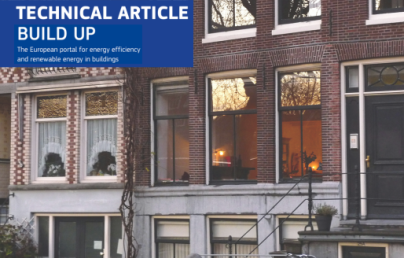Technical Article - Arise article series ‘Digitalisation in the built environment’ #5 Implementation: The benefits of a digitally informed and empowered workforce

Technical Article - Arise article series ‘Digitalisation in the built environment’ #5 Implementation: The benefits of a digitally informed and empowered workforce
Authors
James Harty is a lecturer at KEA, Copenhagen School of Design & Technology. His PhD researched The Impact of Digitalisation on the Management Role of Architectural Technology, (OpenAir RGU). James was instrumental in the schools’ adoption of BIM in 2006, with the implementation of collaborative methodologies and in dealing with disruptive technologies. He has co-authored a book about this, Getting to Grips with BIM, Routledge 2016. He sees BIM as instrumental in tackling climate change, sustainability, especially embodied carbon, and performance-based design. His Masters in Urbanism mapped the housing types and urban morphology of a satellite town near Dublin, Dun Laoghaire, and he was a co-author of a report preserving Temple Bar in Dublin.
Andrew Hamilton, Curriculum Manager - Construction and The Built Environment at Belfast Metropolitan College. Andrew Hamilton is a Chartered Architect with 20 years of professional experience. With 13 years of experience as a lecturer, he is currently the Curriculum Area Manager for Construction and The Built Environment at Belfast Metropolitan College. Over the last 10 years he has significant experience developing BIM qualifications and has participated in two H2020 projects, addressing BIM and digital innovation and teaching.
Eduardo Rebelo, Lecturer in Architecture at Ulster University. Eduardo Rebelo is an architect and currently PT Lecturer in Construction and Engineering in both the Belfast Metropolitan College and the Southern Regional College, and Lecturer in Architecture in Ulster University. With a Master’s Degree in Architecture, from FAUTL, Lisbon, and 19+ years of professional Experience, he has been teaching since 2011, and particularly focused in BIM training for individuals and SME in the AEC sector in the last few years. Eduardo is experienced in both the organisational, management and modelling aspects of BIM. He participated in two H2020 projects- including the ARISE project at present- that addressed upskilling in BIM and digital innovation towards energy efficiency. He gas helped write and deliver qualifications in BIM in the Northern Ireland Education Framework and is an advocate in the adoption of digitisation tools, including BIM as enabling tools to facilitate sustainability, reducing embodied carbon, and reaching performance-based design goals.
(Note: opinions in the articles are of the authors only and do not necessarily reflect the opinion of the EU).
Introduction
A currency of skills means that there is a common exchange and understanding of the skills available. To achieve this common position, there must be empathy and cross-fertilisation of those skills, so that they interlock and position themselves in a large matrix, shoulder to shoulder with their neighbouring skills. This interdependence creates a plethora of skills which form a quilted blanket building into a larger tapestry to aid and abet each other.
Tasked-based learning draws on events to map a learning method. It removes pure theory and makes the deed relatable and identifiable. As a method, it also has a greater chance of being absorbed and remembered because seeing is doing. Makes also potentially more relevant to each individual, and adaptable to the time availability barrier.
Increasingly there is a need to be able to show achievements and gain their merit. There are many cases of cheating and misrepresentation. A method that copper fastens the latter is to have verifiable credentials, where a body will stand over the claims you are making. Blockchain is a solution here, acting as the single source of truth and giving the user control over who can access their credentials while offering the recipient of the data a proof-of-purchase scenario (Harty, Kouider et al. 2016).
Industry 4.0 is here
Digitalising within the construction sector improves efficiency and productivity as well as the quality of your work. Sisk, a major contractor in Ireland, recently completed a Center Parcs development at Longford Forest Holiday Village. The site is 164 Hectares, consisting of a sub-tropical swimming paradise, an aqua/sauna building, an arrivals lodge, cycle centre woodlands buildings, a pancake house and associated amenities and facilities. Accommodation consists of 470 lodges (5 types) dispersed into 78 clusters plus an apartment building bringing the provision of 500 units in the development.
BIM was not part of the project requirements, but Sisk sought to table the process at tender and use a Digital Project Delivery (DPD) approach which was accepted. Center Parcs has now been implemented in all their developments. Synchronisation was achieved using drone footage, which was weekly, and mapped through Synchro so that critical paths could be monitored and maintained. The project was fast-tracked with a value of €65M and it took only 68 weeks in total. They were able to produce three lodges a day using prefabrication techniques and through DPD and Lean Construction, they implemented 4D construction sequencing, Building Information Modelling, ASTA Progress Mobile App and Field View (Kennedy 2019). Field View allowed for quality sign-offs using hand-held devices without the need for paperwork or returning to the site office.
Field View saved an hour a day, for all those involved, allowing 18,500 planned inspections, saving an average of 15 minutes per inspection, resulting in 4,625 man hours saved in total. ASTA is planning software that allows capturing the work rate on-site, with reduced manual input and paperwork, which increases awareness through the team, with quicker data entry and increased added value for planning.
With regard to Lean Construction, three methods were deployed, work sampling, so that the assembly was tested as being the best method of construction, so that all were on board, Just-in-time delivery and kitting, which means each job is quantified at source in the storage area, so that everything needed to complete a task went out with correct quantities, resulting in no waste, and a more efficient work-flow. There was a 22% productivity improvement observed on key trades.
The previous examples show that Industry 4.0 is here. Despite the slow uptake of new technologies, processes, and changes in workflows that characterise the Construction Sector, the digital revolution has been at play for many years now.
It has been spearheaded by those forced by Government Mandates and/or inspired by their benefits. By those driven to improve their methods to get ahead of the competition. Mostly by the brave who dared to risk, learn, and change and improve. Those willing to ARISE.
Digitalisation is playing an increasingly important role in improving efficiency, productivity, and quality in the construction sector. It is a potential enabler for improving and revolutionising how things get done in the Architecture, Construction, and Engineering (AEC) sector, facilitating the path of achieving more efficient buildings.
The main outcomes of digitalisation
Some ways in which digitalisation can achieve these outcomes include:
- Digital tools including Building Information Modelling (BIM): BIM is a digital representation of a building or infrastructure project, which can be used to improve collaboration, reduce reworks, and reduce and enhance the overall quality of construction projects. BIM methodology can have a significant impact on carbon and energy expenditure during both the construction and the utilisation of the building, by allowing better design via digital twins, that allow running of performance simulations such as energy, and solar gains, among others, better design decisions can be made to optimise the predicated performance of build assets. Also, the use of digital clash detection helps avoid the typical errors and reworks, that increase time on site as well as material wastage. Also, the data generated in the BIM process can be passed on to Facility Managers (FM) to allow a more efficient management and running of the assets.
- Project management software: Project management software can be used to streamline project planning and scheduling, enabling construction teams to work more efficiently and effectively.
- Mobile apps and wearable technology: Mobile apps and wearable technology can be used to provide workers with real-time information, training and access to digital tools, improving communication and enabling workers to work more productively.
- Automation and robotics: Automation and robotics technologies can be used to automate routine tasks, freeing up workers to focus on more complex and value-added activities.
- 3D printing and prefabrication: 3D printing and prefabrication technologies can be used to create complex building components in a factory setting, improving quality control and reducing construction times.
By adopting these digital technologies, the construction sector can improve efficiency at all levels.
The array of digital tools and methods caters for every single professional and stakeholder in the AEC sector. Digital skills and tools enable more efficient processes, procedures and quality of work, increasing productivity, and delivering real benefits to construction companies and their clients.
This implies a leap forward, an upskilling of the existing and future workforce. Many professionals still need to catch up its current trends, as for some it implies a journey in the digitalisation pathway from the very basics. For others, it is the integration of processes that have permeated the workspace more than a decade ago, such as BIM. For others, it is improving and building up on their existing skills to integrate more advanced tools and processes. For others, to gain the ability to access all this digital info that becomes available, for example, supervisors, tradespeople, installers, or even energy auditors. It also constantly updates, as digital technologies continue to evolve rapidly, as we can see with the rapid takeover of AI and regenerative design into facilitating the generation of several iterations of design and solutions over a very short time frame.
To be able to achieve the potential benefit of more efficient building assets using digitalisation, the use of these skills needs to become even more widespread, across several European regions. It needs to become more of the norm and the standard that the market will demand from its professionals. More people need to become skilful and have access to the skills needed to become more agile, and to fit the real-time needs of each individual and their available time.
ARISE has developed a comprehensive framework which enables the delivery of a microlearning type of training that addresses this multi-layered, multidisciplined, multitude of skills gap that needs addressing. A nonlinear pathway to upskilling, that allows learners to take control of their training based on their needs and on the knowledge, they need to perform the task their specific role and nature of job requires.
A set of trials, workshops, and training events will take place during 2023 to help bring as many professionals as possible willing to step up this ladder of digital upskilling. Now is the time to catch on with the speeding train that is the Industry 4.0.
Conclusions
There is no turning back!
The AEC industry needs to evolve and adopt digitalisation tools to achieve its future goals and respond to the challenge that we all face, climate change. Just a few trailblazing the way is not enough anymore. A more holistic adoption and implementation is urgent. However, this cannot be achieved without the availability of wide-scale, cross-regional, fast paced, equitable, accessible, and mutually recognised training schemes.
The ability to navigate this plateau and know where and what is happening, is a vital aspect of the new upskilling conditions. Having a role to deliver on these skills is critical to bringing about maximum results for all concerned. It requires programmes that can not only master the situation but also make significant contributions to users, guiding them in the right direction, to successful conclusions.
And with these successful conclusions, there is an increased need for individuals to be able to show these upskilling achievements and gain their merit. As more professionals raise their profiles with new skills, applying them and the benefit of such applications becomes more visible; this will push the market to make these a mandatory benchmark.
For that to happen, a verifiable (with blockchain), and visible method of providing individual credentials (for example digital badges) that professionals can easily showcase on their CVs, is a way to help make the growth of digital skills for the AEC industry more evident, helping to raise and establish that digitalisation benchmark.
These are some of the roles that ARISE aims to fulfil:
- To offer an accessible holistic training scheme that will empower the workforce with digitalisation and BIM skills.
- To facilitate easier application of those set skills to specific roles- via a task-based Framework.
- To help enable the series of benefits, as the ones exemplified in the article, that help reach a more efficient building environment and tackle climate change.
- And provide a visible, verifiable, and recognisable way for accrediting the achievement and merits of each upskilling action, to help stimulate and further push the market demand for those skills.
References
HARTY, J., KOUIDER, T. and PATERSON, G., 2016. Getting to Grips with BIM . UK: Routledge.
KENNEDY, B., 2019-last update, Innovation in Practice - Center Parcs - Sisk [Homepage of Sisk], [Online]. Available: https://vimeo.com/295118963/c174431641 [22nd June, 2020].


